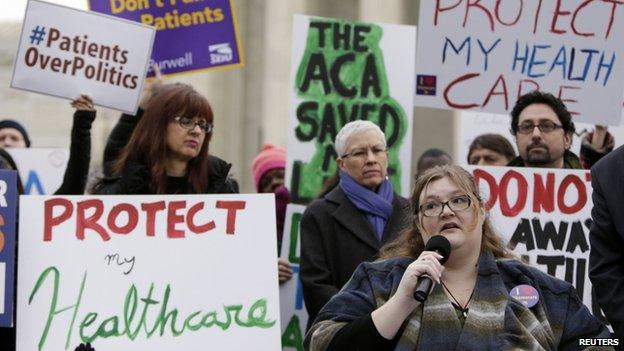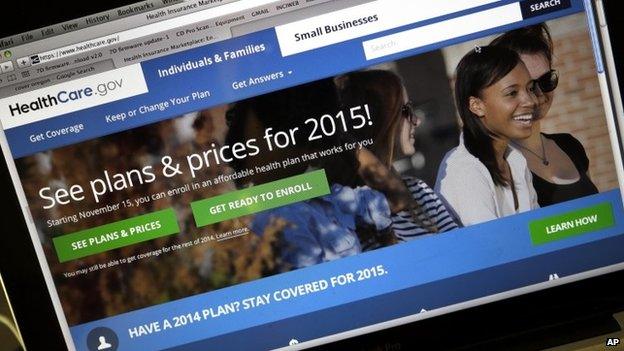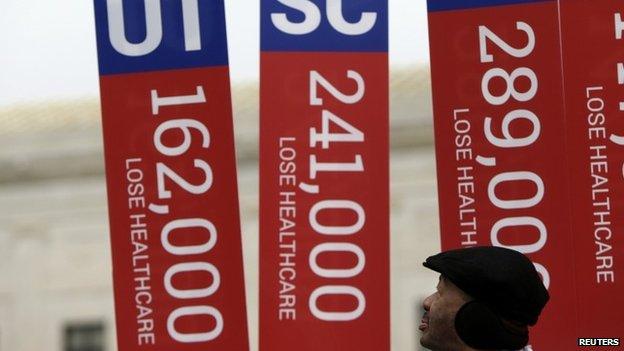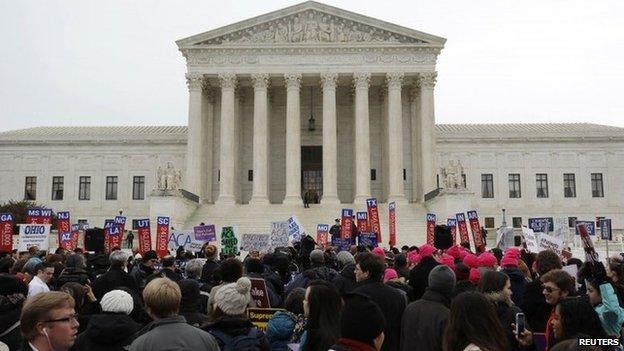What's at stake in the Supreme Court healthcare challenge?
- Published

The US Supreme Court is hearing arguments over a challenge to President Barack Obama's healthcare law that could affect an estimated eight million people. But what's at stake in this case?

What's different in this case from previous challenges to the healthcare law?
There have been two prior challenges against the law at the US high court.
In 2012, the Supreme Court upheld the law's requirement that Americans be covered by health insurance in some way or be subject to a fee at tax time.
Two years later, the court agreed a Christian-owned company could claim a religious exemption to a law requiring employers to pay for their workers' contraception.
While this challenge is not constitutional, it affects a key portion of the law.
Insurance exchanges were set up for individual Americans to buy coverage for themselves and their families if they are not covered by employers or other government-run healthcare programmes.
Some states run their own exchanges, but most Americans who buy insurance this way do so through the federally-run exchange.
Consumers buying insurance through exchanges - whether federal or state-run - are eligible for subsidies that make monthly premium payments more affordable if they meet income requirements.
The plaintiffs argue the law, as written, only extends these subsidies to those who live in states who have set up exchanges.
Specifically, challengers have focused on one sentence in a section providing for the subsidies.
The US government argues such a reading is wrong, given the overall law's clear intent to expand health insurance to as many Americans as possible.


The federal exchange website covers many Americans seeking health insurance outside of employers or government programmes
Why did some states set up exchanges and not others?
The law does not require each state to set up an exchange and many did not do so for either political or technical reasons.
A few states have set up federal-state partnerships. They will not be affected by the case.
Meanwhile, legislatures in a handful of states have proposed bills to create exchanges but their path to passage is unclear.


Millions are expected to lose subsidies if the court rules in favour of the plaintiffs
Who will be affected if the plaintiffs win?
Americans who purchased healthcare insurance through the federally-run exchange would lose their health insurance subsidies.
About 9.3 million people will have to pay their full monthly premium or lose coverage in 2016, according to the non-partisan Urban Institute think tank. About eight million of those people are expected to be unable to afford it.
Some doctors, even those who are convinced the government will win the case, have already begun considering contingency plans for their most at-risk patients, Reuters reports, external.
Many of those affected live in Republican-led states. Nearly two dozen Republican senators facing re-election next year are also from those states and some have suggested attempts to help those affected until the law is rewritten.
In theory, Congress could update the law to clarify the subsidies apply across the board, but that is extremely unlikely in a Republican-controlled Congress that is directly opposed to the law.


What will this mean for the law at large?
While the 2010 law makes many changes to how US health insurance works, one of the underlying aims is to lower healthcare costs.
Critical to that goal is keeping plenty of healthy people insured, and the subsidies were intended to increase that number by lowering the monthly cost of insurance for younger people and those who otherwise could not afford premiums.
If enrolment of largely health people in insurance declines because it is no longer affordable, insurance premiums are expected to rise across the entire market.